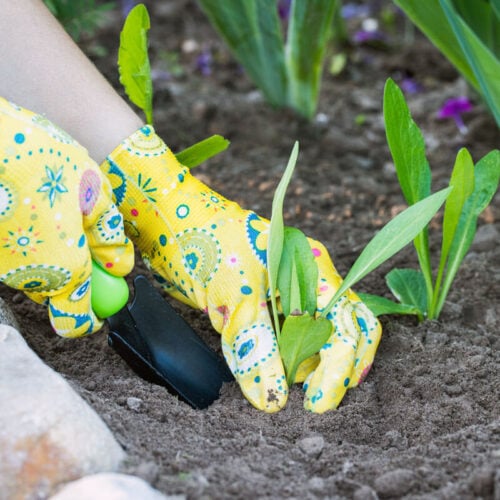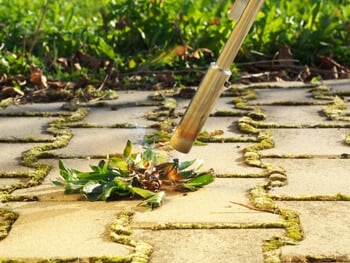Weeds are the bane of every gardener, especially as the days heat up and vacation season starts. But short of hand-digging them every day, it can be a real challenge to stay on top of your weeds before they strangle out your veggies and flowers.
Here are 10 non-toxic ways to handle weeds in your garden…
Skip the Toxic Herbicides
Although hand-digging and hoeing are the most effective methods for removing weeds, it can be tempting to use a little Round-Up or other store-bought herbicide to make quick work of your weeds—especially if they’ve gotten a little out of hand. But there are some very important health and environmental reasons to avoid them.
A study by the Massachusetts Institute of Technology found that glyphosate (Round-Up) residue in food may act synergistically with other food-borne chemical residues and environmental toxins to disrupt normal body functions and lead to the development of Parkinson’s disease, infertility or cancer.
Indeed both the state of California and the World Health Organization have deemed glyphosate to be a probable carcinogen. In fact, Bayer is considering banning Round-Up for U.S. residential use because they keep losing lawsuits by people diagnosed with non-Hodgkin lymphoma after being exposed to glyphosate, Roundup’s active ingredient.
In 2009, a French study found that a filler ingredient used in Roundup called polyethoxylated tallowamine was more deadly to human cells than the main ingredient, glyphosate.
In the environment, glyphosate usage has led to the evolution of glyphosate-resistant weeds covering an estimated 120 million hectares globally. Glyphosate also chelates micronutrients in the soil, leading to decreased photosynthesis, decreased resistance to drought, and increased spread of disease. In fact, more than 40 plant diseases have been linked to glyphosate use.
Glyphosate is toxic to many beneficial micro- and macro-organisms including earthworms. It also harms soil microbes responsible for growth, mineral uptake and disease prevention. In sum, crops grown with or around glyphosate are simply less nutritious.
Glyphosate’s high water solubility makes it extremely toxic to many frog species and other aquatic life. On land, the major decline of Monarch butterfly populations is partially caused by glyphosate applications killing off the milkweed habitat that Monarch larvae need to feed and grow.
Finally, glyphosate has been found to contaminate ground water supplies as well as rain and air in Spain and the US, threatening our drinking water. Glyphosate has also been detected in the bloodstreams of Americans and Europeans at levels exceeding drinking water standards.
To avoid these serious long-term health and environmental effects, skip the Round-Up and other herbicides, and try some of these effective, organic methods to control your weeds instead.
Related
- What is a GMO and Why Should You Care?
- Organic Garden Disease Control
- The Difference Between Open Pollinated, Hybrid and GMO Seeds
10 Organic Weed Control Methods
1. Mulching
Covering your garden soil with a layer of organic matter can smother and inhibit weeds, as well as prevent new seeds from germinating. Good sources of mulch include wood chips, compost, grass clippings, and straw. Just be sure not to get hay, which can contain a lot of unwanted seeds.
You can also put down ground cloth, newspaper, cardboard, old cotton curtains or bed sheets, landscape fabric, or other thick material on your soil to prevent weeds from growing through. This is especially helpful to do in your garden pathways before you put down gravel, stone or wood chips.
2. Crowding

Weeds can’t take hold in your garden if there’s no space for them.
In ornamental beds, plant groundcovers and perennial plants to cover and shade the soil.
In your vegetable gardens, try either the Square-Foot gardening method or wide-row planting method so that your plant leaves will just touch each other at maturity. As the plants grow, their leaves will shade the bed and deprive weeds of sunlight.
3. Limit Tilling and Digging
Tilling or turning over your garden soil will bring new weed seeds to the surface. Instead, try using the no-till method of gardening or Lasagna gardening, where you disturb the soil as little as possible.
If you are planting seeds, only dig down as far as you need to plant them, instead of tilling up the entire bed. The no-till method also improves soil structure and fertility, and increases the population beneficial organisms in the soil.
4. Solarizing

Solarizing your soil involves covering an area of weedy ground with a clear, heavy plastic sheet. (Black plastic does not work as well.) This only works in full sun and warm weather where the heat will collect under the sheet and literally cook your weeds. Leave the sheet in place for 4 to 6 weeks, and remove only once all the weeds are brown and dry.
For even more effectiveness, till the soil to bring weed seeds to the surface, and let them sprout just before solarizing.
5. Fertilize and Irrigate Carefully
The nutrients and water you give to your garden will help weeds grow just as much as they will help the veggies and flowers you want. Only give your plants what they need.
Use drip irrigation, irrigation bags or olla pots to provide water only to the roots of your plants, not the empty spaces around them. Give heavy feeders like squash, tomatoes and cucumbers extra compost, but feed crops like root vegetables much less.
6. Boiling Water
Boil a kettle of water and pour it over any weeds to burn them. This technique is great for weeds growing in the cracks of pavement and coming up in your garden paths. The water will cool as it runs off so it won’t hurt any plants you want to keep.
7. Vodka or Rubbing Alcohol
Try this weed-killing recipe on your annual weeds growing in full sun:

Alcohol-Based Weed Killer
Equipment
Ingredients
- 2 ounces rubbing alcohol, or cheap vodka
- 2 cups purified water
- 3-4 drops dish soap
Instructions
- Mix everything into a small spray bottle. Spray on weeds to dry them out and kill them.
- Be careful not to spray on any of your regular plants, because the alcohol will dry out whatever it hits. This spray does not work well in shady areas.
8. Vinegar
This vinegar mix is good for drying out weeds too, though you may have to apply it multiple times on weeds with a long taproot, like dandelion.

Salt and Vinegar Weed Killer
Ingredients
- 1 gallon white vinegar, 5% or up to 20% vinegar
- 1 cup salt
- 1 Tbsp. dish soap
Instructions
- Wearing gloves and goggles, mix everything into a sprayer and spray directly onto your weeds, making sure to avoid the plants you want. It works even better in full sun.
If you use 20% or 30% vinegar (available online), this formula will work much better, but the vinegar is so acidic, you will need to use gloves and goggles to ensure any spray doesn’t blow back and burn your skin or eyes.
9. Corn Gluten
Corn gluten meal is a byproduct of the corn milling process that just so happens to prevent weed seeds from germinating. It does nothing to kill weeds once they have sprouted, however.
Corn gluten meal is often applied to lawns to prevent crabgrass and dandelions from sprouting, but it can be used in other garden areas, after the seeds you want have sprouted.
It’s non-toxic, and if you buy certified organic corn gluten meal, there will be no GMOs or glyphosate residue. If you can’t find it in your local garden center, corn gluten meal is available online.
10. Flame weeders

A flame weeder is a wand connected to a propane tank which enables you to pass a flame over a weed in order to fatally heat the plant tissues. Flaming will only kill the leaves above the ground, not the roots, so you may need to flame your weeds a few times before they’re gone.
Flame weeders are extremely effective on all types of weeds, and if you have a large garden or small farm, they are worth the investment. Just take great care when using a flame weeder during a dry spell, when there is a risk of fire.
You can find flame weeders in garden and hardware stores, or online.
With so many great organic weed control methods to try, why would you ever grab a bottle of that toxic stuff?
Recommended in This Article
Updated June 28, 2023












